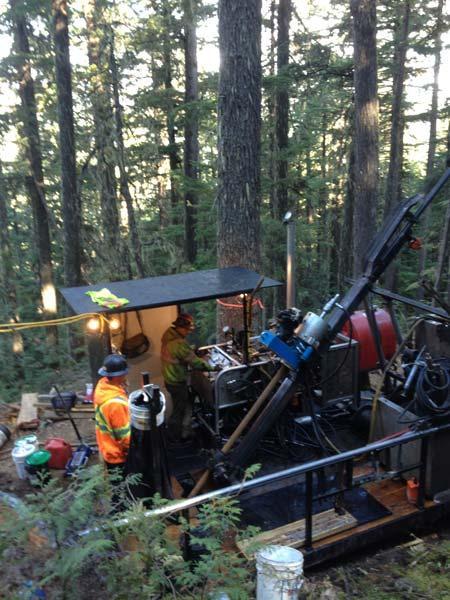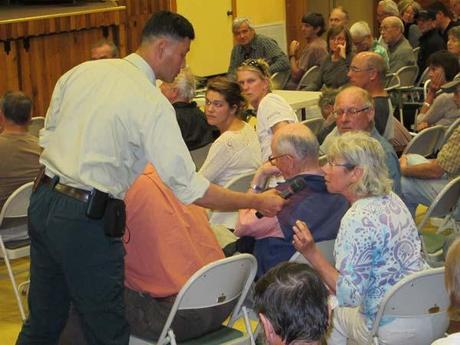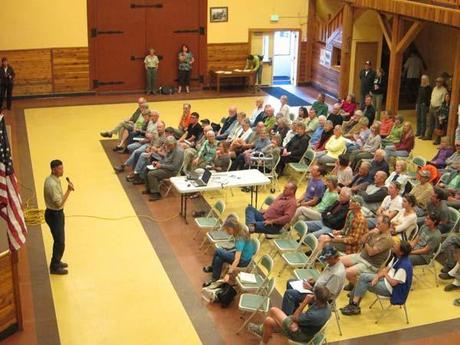
The drill rigs the company plans on using are similar to the pictured equipment. Photo courtesy USFS
by Ann McCreary / Methow Valley News
In his five years as Methow Valley District Ranger, Mike Liu said he has not seen an issue that has generated as much interest as the proposed exploratory drilling for copper on U.S. Forest Service land near Flagg Mountain in Mazama.
Concerns about the “Mazama Copper Project” drew more than 100 valley residents to an informational meeting hosted Monday (May 19) by the Methow Ranger District.
The Forest Service has received almost 600 comments about the proposal following release last month of a scoping letter describing the project, said Victoria Wilkins, environmental coordinator for the district.
The public comment period was initially intended to close May 17, but will be extended through the end of May, Forest Service officials announced Monday.
Those attending Monday night’s meeting raised a host of questions, some of them technical and some of them procedural. Liu said he couldn’t answer some of the questions until more analysis of the proposal is completed.
The project calls for drilling up to 15 test holes, up to 980 feet deep, on Forest Service land north of Goat Creek Road in Mazama. The project is proposed by Blue River Resources Ltd., headquartered in Vancouver, B.C., which has interest in mineral rights on the land. The company wants to begin drilling in late summer if it receives the required permits from the Forest Service.
Some speakers at Monday’s meeting asked the Forest Service to turn down the project. But Liu explained that under longstanding federal mining law, the Forest Service cannot deny the company the right to explore mineral claims to which it has statutory rights.
“I do not have the authority to go against the Mining Act of 1872,” Liu said. “I have purview over the environmental analysis … and what type of mitigation or requirements are needed” to meet federal and state laws governing endangered species, clean air and water.
Liu acknowledged that the exploratory drilling proposal raises fears that the area might someday become an open pit copper mine. But that can’t happen without new and extensive analysis and public involvement, he said.
“If this progresses, if there are suitable deposits, [mining] can’t progress further without coming back to the Forest Service with a plan of operations. We would have to reanalyze, there would be another public scoping and … an environmental analysis or environmental impact statement,” Liu said. “This does not trigger some kind of approval for a strip mine.”
Some mining company representatives were present at the meeting, but did not identify themselves.
Blue River Resources plans to conduct the drilling in day and night shifts and estimates the work will take about two months. Because the project is a short-term mineral exploration lasting less than a year and proposes no new road construction, it qualifies as “categorically excluded” under federal environmental law from more extensive study under an environmental assessment or environmental impact statement.Categorically excluded?
If the Forest Service finds, however, that there are “extraordinary circumstances” that involve significant environmental impacts, the project could require a more detailed analysis, Wilkins said.
There are seven areas of consideration that could present extraordinary circumstances if they were significantly impacted. They include threatened and endangered species or critical habitat; flood plains, wetlands or municipal watersheds; Congressionally designated areas such as wilderness or national recreation areas; inventoried roadless or potential wilderness areas; research natural areas; American Indian and Alaska Native religious or cultural sites; and archaeological sites.
The mere presence of any of those considerations doesn’t preclude analyzing the project as a categorical exclusion, Wilkins said. “The degree of impact to the resources determines if we can’t use a categorical exclusion,” she said.
An interdisciplinary team of biologists, geologists and other Forest Service staff is currently analyzing extraordinary circumstances related to the drilling project. If it determines that no further analysis is needed, Liu would issue a decision memo to approve the project.
That decision, Liu explained, is not subject to administrative appeal. The only recourse would be to sue the agency, he said.
If the current analysis indicates a need for further study through an environmental assessment or impact statement, the Forest Service would launch a new scoping process and comment period.
The area to be drilled is known to include critical habitat for Northern spotted owls, which are protected as threatened under the federal Endangered Species Act. In order to avoid impacting the owls, the Forest Service is requiring that drilling not begin until Aug. 1, after the owls’ nesting season is over. Drilling would have to end Nov. 31, when Goat Creek Road is closed and groomed as a snowmobile trail.
Blue River Resources wants to begin drilling as soon as possible after Aug. 1, but the onsite analysis and volume of comments received may delay the process, Liu said.
“I have to prioritize what we spend our time and scarce resources on,” Liu said. “While we do receive some minerals funding, in terms of the analysis we have to complete, and the content analysis of the comments, I’m not sure we have the capacity to do that by Aug. 1. At this point, given my staff’s capacity, we’re limited.”
a

Drilling impacts
Blue River Resources first approached the Forest Service about a year ago with the goal of beginning drilling last September. The company has been in conversation with Forest Service officials over the past year and recently submitted an updated Plan of Operations that is available on the Forest Service website.
The new plan changed the proposed drilling depth from 1,900 feet to 980 feet, which shortens the amount of time needed to complete 15 holes. The drilling would be done by a drill that would be moved from site to site on skids and housed in an 11-by-16-foot drill shack.
The noise of the drill measures about 92.5 decibels, said Jennifer Zbyszewski, recreation, wilderness and minerals program manager for the Methow Ranger District. A lawnmower produces about 90 decibels and a chainsaw about 100 decibels, she said.
Bill Pope, owner of the Mazama Country Inn, said the Forest Service needs to consider the “noise pollution” that could result from drilling noise bouncing off the narrow walls of the northern valley. “Anywhere in the upper valley you can hear a Harley going up and down the road. How would the [drill] noise be transferred or reflected off the valley walls?”
A sump would be dug next to each drill site to collect a slurry-like material produced by drilling. After each drill hole is completed, the mining company will be required to plug the hole and fill and seal the sump before moving to the next drill site, Zbyszewski said.
Traffic at the site is expected to be four trips by pickup truck and one or two trips by water truck. Water used in the drilling would be brought in from a source off Forest Service land. Zbyszewski said the source of the water is not known, but would have to pass clean water standards. Nighttime drilling would be illuminated by four 50-watt bulbs, she said.
The Forest Service will require the mining company to post a bond to ensure that reclamation of the site is completed when the project is finished.
“We’ll be up there every day” monitoring the project if and when it gets underway, Zbyszewski said.

Many concerns
Among the hundreds of comments received on the proposal, Wilkins said, writers have focused on impacts on wildlife and fish; surface and groundwater; vegetation; noise from the drills; light pollution from drilling at night; air quality; traffic; recreation and the recreation-based economy; and overall quality of life.
A letter from Methow Valley Citizens Council (MVCC) asserted that the project does not qualify for categorical exclusion and requires more in-depth environmental analysis.
MVCC cited potential impacts on federally listed threatened and endangered species — including the Northern spotted owl, gray wolf, Western gray squirrel, lynx, wolverine and endangered fish — as extraordinary circumstances that require more extensive analysis.
The upper Methow Valley is one of only 14 “Treasured Landscapes” chosen by the Forest Service in the entire national forest system, MVCC said. That designation calls for restoring damaged forests, and the proposed drilling “is contrary to the intent of the Treasured Landscape designation,” according to MVCC.
MVCC also called on the Forest Service to consider the “significant impact of the proposed drilling … on the tourist economy of the entire Methow Valley.”
The area around Flagg Mountain proposed for drilling has been explored on several occasions over the past 40 years by other mining companies. New drilling may be desired to confirm historical data, and determine if it meets current standards, said Mark Gingrich, minerals administrator with the Forest Service.
The updated Plan of Operations submitted by Blue River Resources for the project is available online at www.fs.fed.us/nepa/nepa_project_exp.php?project=44438.
Comments on the project may be sent by email to comments-[email protected].
Written comments can be submitted to Michael Liu, Methow Valley Ranger District, 24 W. Chewuch Road, Winthrop, WA 98862. The Forest Service recommends that comments be solution-oriented and provide specific examples.

